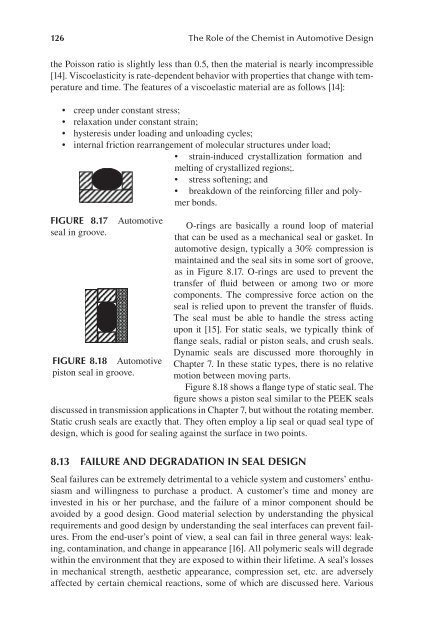THE ROLE OF THE
THE ROLE OF THE
THE ROLE OF THE
Create successful ePaper yourself
Turn your PDF publications into a flip-book with our unique Google optimized e-Paper software.
126 The Role of the Chemist in Automotive Design<br />
the Poisson ratio is slightly less than 0.5, then the material is nearly incompressible<br />
[14]. Viscoelasticity is rate-dependent behavior with properties that change with temperature<br />
and time. The features of a viscoelastic material are as follows [14]:<br />
•<br />
•<br />
•<br />
•<br />
creep under constant stress;<br />
relaxation under constant strain;<br />
hysteresis under loading and unloading cycles;<br />
internal friction rearrangement of molecular structures under load;<br />
• strain-induced crystallization formation and<br />
melting of crystallized regions;.<br />
• stress softening; and<br />
• breakdown of the reinforcing filler and polymer<br />
bonds.<br />
FIgure 8.17 Automotive<br />
seal in groove.<br />
FIgure 8.18 Automotive<br />
piston seal in groove.<br />
O-rings are basically a round loop of material<br />
that can be used as a mechanical seal or gasket. In<br />
automotive design, typically a 30% compression is<br />
maintained and the seal sits in some sort of groove,<br />
as in Figure 8.17. O-rings are used to prevent the<br />
transfer of fluid between or among two or more<br />
components. The compressive force action on the<br />
seal is relied upon to prevent the transfer of fluids.<br />
The seal must be able to handle the stress acting<br />
upon it [15]. For static seals, we typically think of<br />
flange seals, radial or piston seals, and crush seals.<br />
Dynamic seals are discussed more thoroughly in<br />
Chapter 7. In these static types, there is no relative<br />
motion between moving parts.<br />
Figure 8.18 shows a flange type of static seal. The<br />
figure shows a piston seal similar to the PEEK seals<br />
discussed in transmission applications in Chapter 7, but without the rotating member.<br />
Static crush seals are exactly that. They often employ a lip seal or quad seal type of<br />
design, which is good for sealing against the surface in two points.<br />
8.13 FaIlure and degradatIon In seal desIgn<br />
Seal failures can be extremely detrimental to a vehicle system and customers’ enthusiasm<br />
and willingness to purchase a product. A customer’s time and money are<br />
invested in his or her purchase, and the failure of a minor component should be<br />
avoided by a good design. Good material selection by understanding the physical<br />
requirements and good design by understanding the seal interfaces can prevent failures.<br />
From the end-user’s point of view, a seal can fail in three general ways: leaking,<br />
contamination, and change in appearance [16]. All polymeric seals will degrade<br />
within the environment that they are exposed to within their lifetime. A seal’s losses<br />
in mechanical strength, aesthetic appearance, compression set, etc. are adversely<br />
affected by certain chemical reactions, some of which are discussed here. Various







